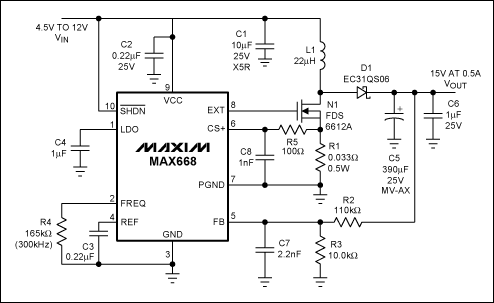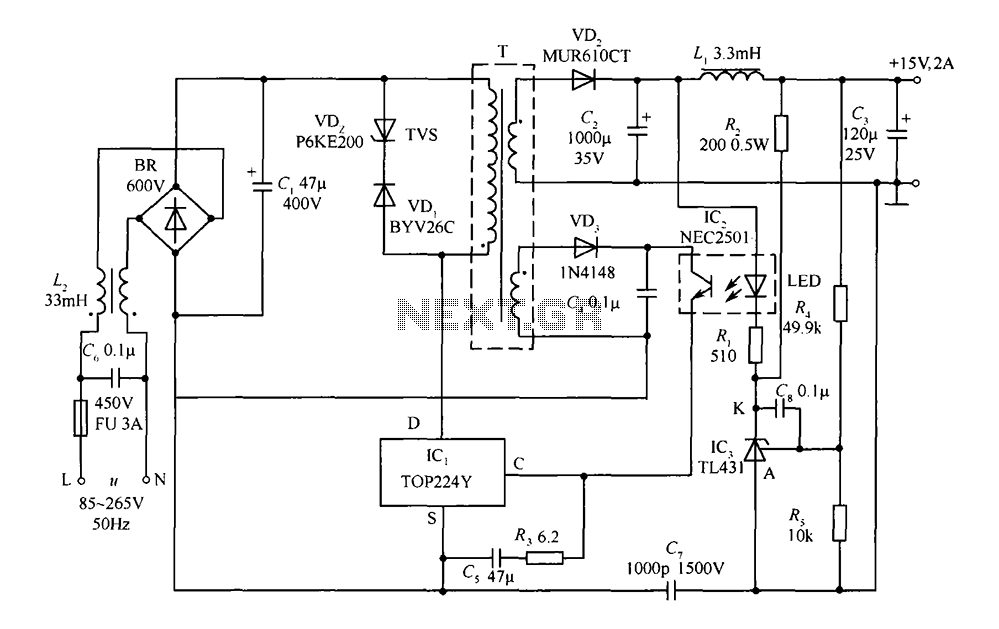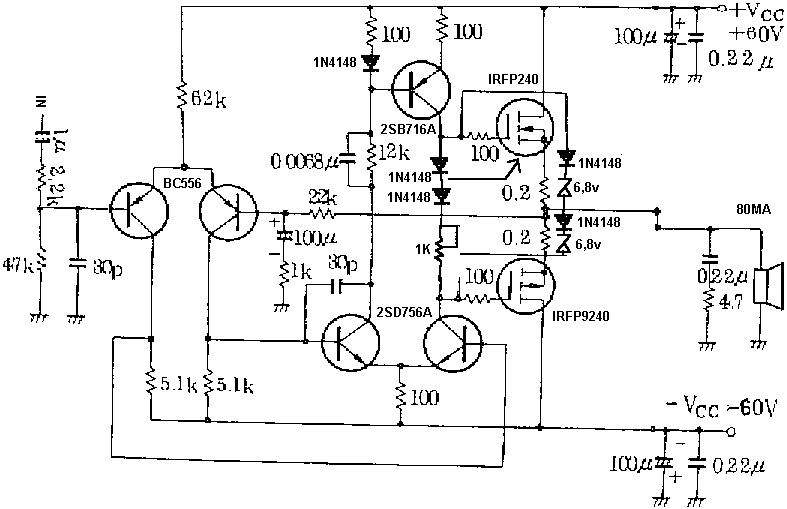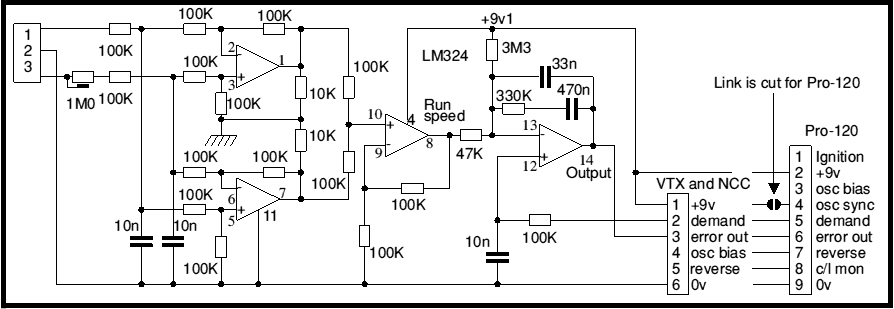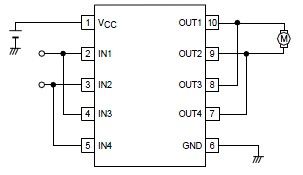
GSM Remote Control 2 IN and 2 OUT Part 2 Schematic
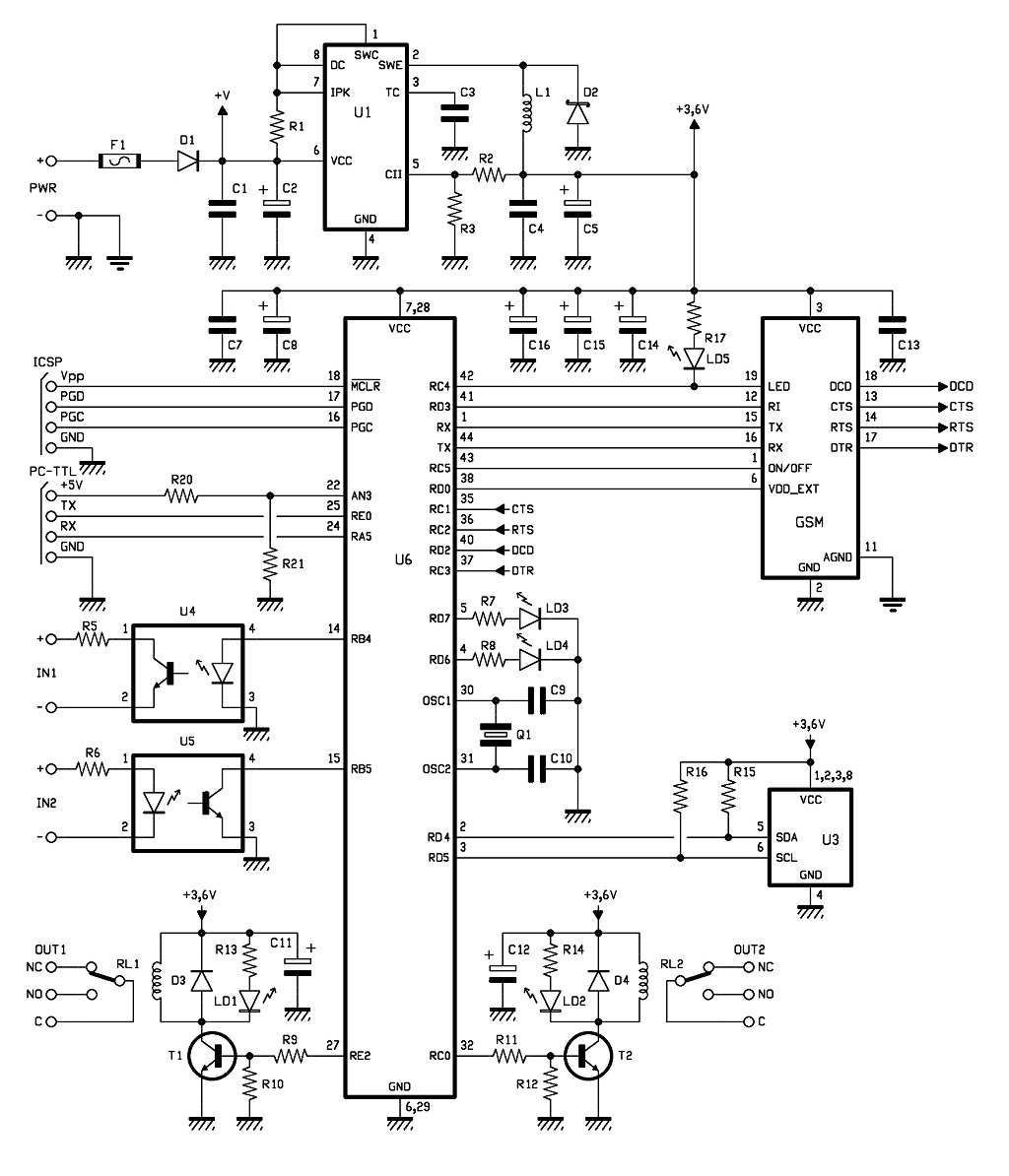
The control of the system is managed by a Microchip PIC18F46K20-I/PT microcontroller, which is programmed with firmware to oversee the activity of the GSM/GPRS module, monitor the logic conditions of two opto-isolated inputs, and send commands to two relays within the device. Power is supplied by a continuous voltage source, which may not always be stabilized, ranging from 5 to 32 V, applied to the PWR terminals (+ and -). This voltage is filtered through a diode (D1) that protects against polarity inversion, followed by capacitors C1 and C2. Fuse F1 protects both the circuit and the power source in the event of a short circuit in the integrated regulator, which is essential for generating the 3.6 V required for the operation of the rest of the circuit. The switching regulator U1, based on the MC34063 chip, operates in a classic PWM configuration and is charged by an inductor (L1); its output voltage relies on the energy stored in the inductor. The regulator is stabilized by a resistive divider (R2/R3) to set the output voltage at 3.6 V. The switching impulses from the inductor are smoothed by capacitors C4 and C5. The 3.6 V output from these capacitors is further filtered by additional capacitors on the power lines for both the microcontroller and the GSM module. During transmission, the GSM module experiences current spikes that are compensated by capacitors C7, C8, C13, C14, C15, and C16, ensuring that impulsive current demands do not disturb the microcontroller's operation. The PIC operates with an internal clock oscillator, although the schematic and printed circuit board are equipped with an external quartz oscillator for potential firmware modifications and applications requiring an external clock. After initializing the I/O lines, the microcontroller checks the logical states of the opto-isolated inputs (RB4 and RB5) as well as lines RC4, RC5, RD0, RD3, and RX, which are necessary for receiving notifications from the cellular module. Specifically, RD3 detects incoming calls by interfacing with the RI pin of the cellular module, while RC4 controls the GSM field LED, which pulses at 1 Hz when the module is searching for a network and provides logical zero pulses for 0.5 seconds followed by a 2-second pause when a signal is detected. The frequency and duration of these pulses allow the PIC to assess the radio-mobile network conditions and respond appropriately. For instance, if the opto-isolated input is deactivated and an SMS or call needs to be sent, the system will wait until the GSM/GPRS module reconnects to the network before proceeding. The microcontroller features a UART accessible via pins 44 (TX) and 1 (RX) for communication with the mobile module. Pin TX is used to periodically check for received SMS messages, while both TX and RX facilitate communication during calls and message exchanges. Control signals for the UART include CTS (Clear To Send), RTS (Request To Send), and DCD (Data Carrier Detect), corresponding to those of the cellular module. Lines RC5 and RD0 complete the I/O connections for the mobile; RC5 manages the power state of the GSM module via a transistor on the mobile's board, while RD0 handles the reset function for the mobile. A button for local control of the device's operating mode is connected to line RA3, configured as an input with an external pull-up resistor (R11).
The schematic design incorporates a robust power management system that ensures stable operation across a wide voltage range. The use of a switching regulator allows for efficient power conversion, minimizing heat generation and maximizing reliability. The inclusion of multiple capacitors for filtering ensures that voltage spikes do not interfere with the microcontroller's operation, which is critical for maintaining the integrity of communication with the GSM module.
The microcontroller's firmware is designed to efficiently manage I/O operations, ensuring timely responses to incoming calls and messages. The opto-isolated inputs provide electrical isolation, enhancing the system's resilience to external interference. The design also allows for flexibility in firmware development, with options to utilize an external oscillator for applications requiring precise timing.
In terms of communication, the UART interface facilitates seamless data exchange between the microcontroller and the GSM module, accommodating various control signals that enhance the reliability of message transmission and reception. This comprehensive design approach ensures that the system remains responsive and functional, even in challenging operational environments. The integration of protection components, such as fuses and diodes, further enhances the durability and safety of the circuit, making it suitable for a wide range of applications in automated control systems.The entire control is handled by a Microchip PIC18F46K20-I/PT microcontroller, programmed with a firmware that controls the GSM/GPRS module`s activity, reads the logic condition of the two opto-isolated inputs and sends commands to the two relays in the device. Having said that, let`s take a better look at the electrical scheme: power is supplied by continuous voltage, not always stabilized (applied to PWR, + and -) at a value between 5 and 32 V; such voltage is filtered at the bottom by the diode protecting against polarity inversion (D1) through condensers C1 and C2. Fuse F1 enables you to protect both the circuit and the power source in case of short circuit in the integrated regulator discussed below, which is necessary to obtain the 3.
6 V, needed for the rest of the circuit to work. The switching regulator U1 is based on a MC34063 chip, used in the classic configuration of the PWM regulators series, charged by inductance, whose output voltage depends on the energy stored in L1; the regulator is stabilized by the component demoted from resistive divider R2/R3, which is needed to set the output tension at 3. 6 V. The impulses produced by the inducer`s switching are then leveled by condensers C4 and C5. The 3. 6 volts at the bottom of the above mentioned condensers are then filtered by other condensers placed on the power lines of the microcontroller and of the GSM module; which presents, during transmission, absorption peaks compensated for by C7, C8, C13, C14, C15 and C16, thus avoiding that an impulsive current request may cause the microcontroller to be disturbed.
The PIC is used in the configuration with an internal clock oscillator; both the scheme and the printed circuit are nevertheless equipped with external quartz, intended for those who want to modify the firmware and develop applications requiring an external oscillator. Once the I/O lines have been initialized, the microcontroller verifies the logical state of the opto-isolated inputs at voltage level (RB4 and RB5) as well as that of lines RC4, RC5, RD0, RD3, RX, which are needed to receive the main notifications from the cellular module; more specifically, RD3 is used to detect incoming calls (it interfaces with RI of the cellular module), while RC4 controls the GSM field LED , whose output (dubbed LED) pulses at a frequency of 1 Hz when the module is searching for the radio-mobile network, and supplies impulses at logical zero, lasting 0.
5 seconds, followed by a 2-second pause, when the module has grasped the signal. The frequency and duration of the impulses enable the PIC to understand the conditions of the radio-mobile network range and to behave accordingly; for example, if the opto-isolated input goes off and therefore needs to send SMS or make calls, but detects that the cellular module has no reception, it waits for the module to get reconnected to the GSM/GPRS network before making any calls. The microcontroller contains a UART accessible via pins 44 (transmission) and 1 (reception) which it uses in order to communicate with the mobile; more precisely, through the first pin (TX), it cyclically questions the module to check whether any SMS has been received, whereas both TX and RX are used for the communication between the microcontroller and the GSM module when making calls and receiving or sending messages.
Regarding the UART, the following control signals are used: CTS (Clear To Send), RTS (Request To Send) and DCD (Data Carrier Detect), which correspond to those of the cellular module being used. Lines RC5 and RD0 complete the set of I/Os destined to the mobile; the former controls the turning on and off of the GSM (through a transistor placed in the small board of the mobile), the latter takes care of resetting the mobile.
The button for locally handling this device`s operating mode is read through line RA3, set as input and equipped with an external pull-up resistor (R11), therefor 🔗 External reference
The schematic design incorporates a robust power management system that ensures stable operation across a wide voltage range. The use of a switching regulator allows for efficient power conversion, minimizing heat generation and maximizing reliability. The inclusion of multiple capacitors for filtering ensures that voltage spikes do not interfere with the microcontroller's operation, which is critical for maintaining the integrity of communication with the GSM module.
The microcontroller's firmware is designed to efficiently manage I/O operations, ensuring timely responses to incoming calls and messages. The opto-isolated inputs provide electrical isolation, enhancing the system's resilience to external interference. The design also allows for flexibility in firmware development, with options to utilize an external oscillator for applications requiring precise timing.
In terms of communication, the UART interface facilitates seamless data exchange between the microcontroller and the GSM module, accommodating various control signals that enhance the reliability of message transmission and reception. This comprehensive design approach ensures that the system remains responsive and functional, even in challenging operational environments. The integration of protection components, such as fuses and diodes, further enhances the durability and safety of the circuit, making it suitable for a wide range of applications in automated control systems.The entire control is handled by a Microchip PIC18F46K20-I/PT microcontroller, programmed with a firmware that controls the GSM/GPRS module`s activity, reads the logic condition of the two opto-isolated inputs and sends commands to the two relays in the device. Having said that, let`s take a better look at the electrical scheme: power is supplied by continuous voltage, not always stabilized (applied to PWR, + and -) at a value between 5 and 32 V; such voltage is filtered at the bottom by the diode protecting against polarity inversion (D1) through condensers C1 and C2. Fuse F1 enables you to protect both the circuit and the power source in case of short circuit in the integrated regulator discussed below, which is necessary to obtain the 3.
6 V, needed for the rest of the circuit to work. The switching regulator U1 is based on a MC34063 chip, used in the classic configuration of the PWM regulators series, charged by inductance, whose output voltage depends on the energy stored in L1; the regulator is stabilized by the component demoted from resistive divider R2/R3, which is needed to set the output tension at 3. 6 V. The impulses produced by the inducer`s switching are then leveled by condensers C4 and C5. The 3. 6 volts at the bottom of the above mentioned condensers are then filtered by other condensers placed on the power lines of the microcontroller and of the GSM module; which presents, during transmission, absorption peaks compensated for by C7, C8, C13, C14, C15 and C16, thus avoiding that an impulsive current request may cause the microcontroller to be disturbed.
The PIC is used in the configuration with an internal clock oscillator; both the scheme and the printed circuit are nevertheless equipped with external quartz, intended for those who want to modify the firmware and develop applications requiring an external oscillator. Once the I/O lines have been initialized, the microcontroller verifies the logical state of the opto-isolated inputs at voltage level (RB4 and RB5) as well as that of lines RC4, RC5, RD0, RD3, RX, which are needed to receive the main notifications from the cellular module; more specifically, RD3 is used to detect incoming calls (it interfaces with RI of the cellular module), while RC4 controls the GSM field LED , whose output (dubbed LED) pulses at a frequency of 1 Hz when the module is searching for the radio-mobile network, and supplies impulses at logical zero, lasting 0.
5 seconds, followed by a 2-second pause, when the module has grasped the signal. The frequency and duration of the impulses enable the PIC to understand the conditions of the radio-mobile network range and to behave accordingly; for example, if the opto-isolated input goes off and therefore needs to send SMS or make calls, but detects that the cellular module has no reception, it waits for the module to get reconnected to the GSM/GPRS network before making any calls. The microcontroller contains a UART accessible via pins 44 (transmission) and 1 (reception) which it uses in order to communicate with the mobile; more precisely, through the first pin (TX), it cyclically questions the module to check whether any SMS has been received, whereas both TX and RX are used for the communication between the microcontroller and the GSM module when making calls and receiving or sending messages.
Regarding the UART, the following control signals are used: CTS (Clear To Send), RTS (Request To Send) and DCD (Data Carrier Detect), which correspond to those of the cellular module being used. Lines RC5 and RD0 complete the set of I/Os destined to the mobile; the former controls the turning on and off of the GSM (through a transistor placed in the small board of the mobile), the latter takes care of resetting the mobile.
The button for locally handling this device`s operating mode is read through line RA3, set as input and equipped with an external pull-up resistor (R11), therefor 🔗 External reference
